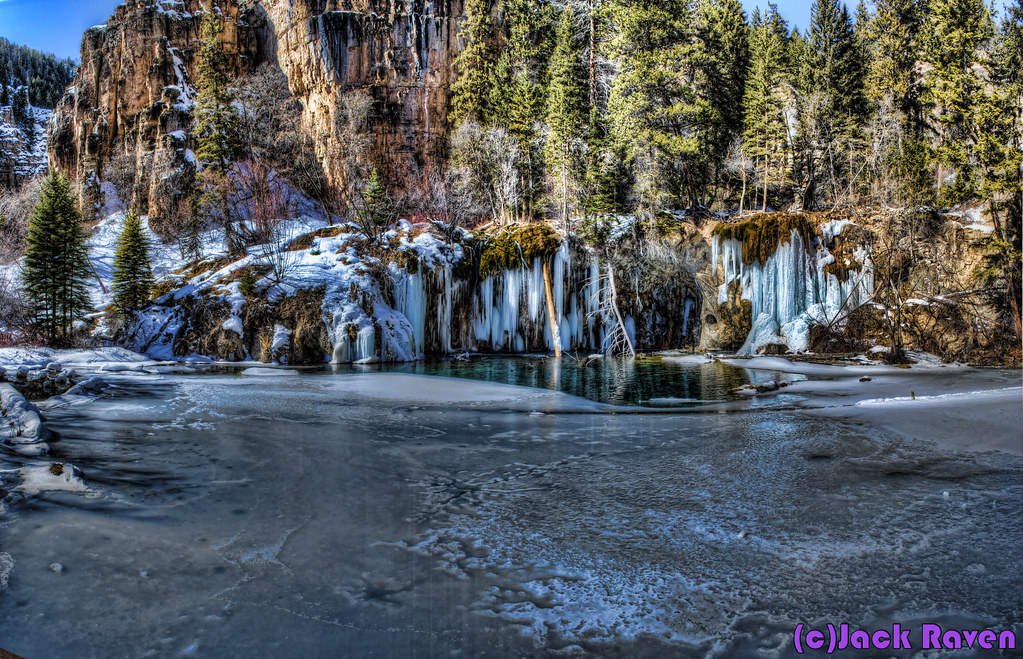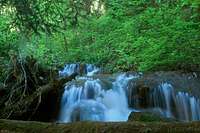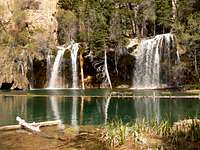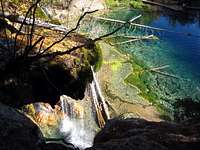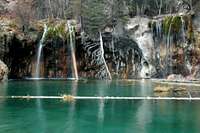-
 33479 Hits
33479 Hits
-
 87.31% Score
87.31% Score
-
 24 Votes
24 Votes
|
|
Area/Range |
|---|---|
|
|
39.56356°N / 107.16527°W |
|
|
Trad Climbing, Sport Climbing, Bouldering |
|
|
Spring, Summer, Fall, Winter |
|
|
Hanging Lake
Hanging Lake is the Gem of Glenwood Canyon
There's a good reason this is one of the most popular hikesin the state of Colorado.Geologically speaking, there are few places in the world that can compare tothis marvel of Mother Nature. Hanging Lake is a rare example of a lake formed by travertine deposition where the natural geologic and hydro-logic processes continue to operate as they have done throughout the history of the lake. The site is also noteworthy for its thriving hanging garden plant community. Because of these qualities Hanging Lake was designated a National natural Landmark by the Secretary of the Interior in 2011.
While Hanging Lake may be a geologic wonder, its popularity with Colorado travelers has more to do with its awe-inspiring beauty. Suspended on the edge of Glenwood Canyon's cliffs, the clear turquoise lake and the waterfall that spills into it are a breathtaking sight after the uphill climb. The stocked lake is teeming with native trout, but don't think about bringing fishing gear or even you dog, both are strictly prohibited on this hike. Instead, bring your camera to capture memories of this photogenic site.
The Hanging Lake trailhead is located approximately 10 miles east of Glenwood Springs along Interstate-70 in Glenwood Canyon.The trail follows Dead Horse Creek, with foot bridges spanning the creek along the way. If the trail seems a little rigorous, hikers can take a break at one of many convenient rest spots. Near the top, the trail becomes rocky and steep, but handrails help guide visitors to the boardwalk that frames a portion of the lake. Since you made the trek to Hanging Lake, be sure to follow the signs the short distance to Spouting Rock, where icy water from snow-melt high atop the Flat Tops barrels through a narrow hole in the limestone rock, spraying hikers with an invigorating mist of cold water.
Though the trail is only a little over a mile long, it is steep and rocky in places. Hikers are advised to bring adequate hydration andwear sturdy shoes. Because the trail is so popular, parking can be a challengeduring the peak summer weekends.
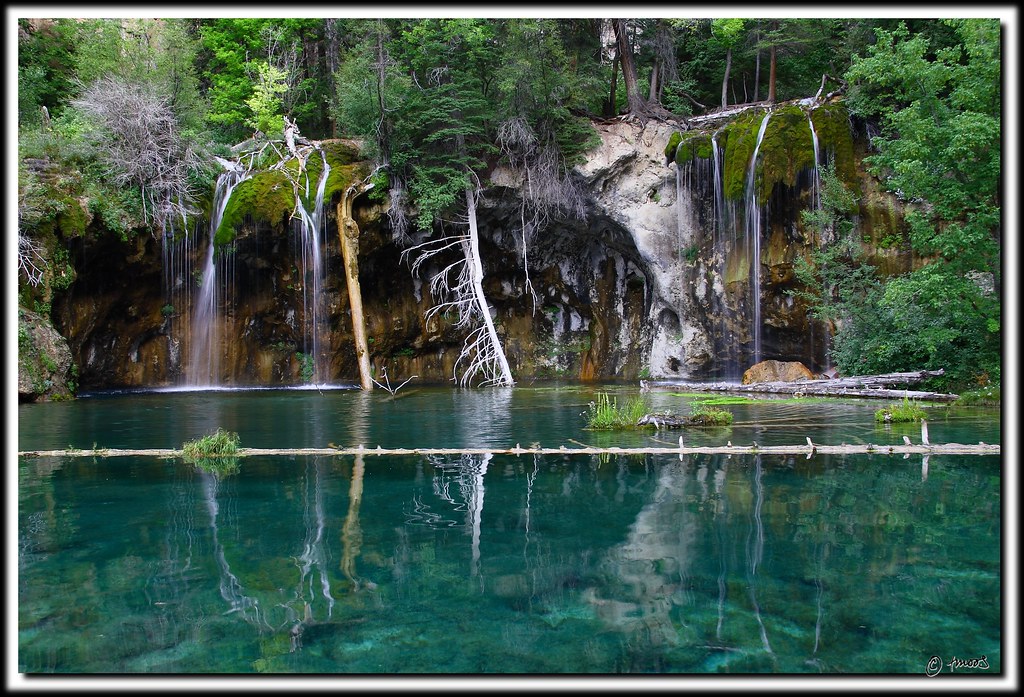
Getting There
Location/Directions
Hanging Lake is approximately 7miles east of Glenwood Springs and the trailhead to reach the lake is just offof I-70. If driving east on I-70, simply take exit 125 and you’ll find thetrailhead at the end of the bike path from Hanging Lake Rest Stop. If drivingwest on I-70 (coming from Denver), you’ll have to exit at the Grizzly CreekRest Area and turn around, getting back on I-70 East and exiting at the exitmarked Hanging Lake.
Parking Advice
When the parking lot is full, it is best to exita nd return another time. Parking on the entrance or exit ramps of I-70 is prohibited. Please follow all posted directions at the parking area, on the trail, and at the lake. Go when it’s slow: to limit traffic, visitors should plan their trip to Hanging Lake for a quieter time—such as a week day, or during the winter season, or plan alternative transportation to the parking lot. Peak visitation occurs on weekends and in the summer. The trailhead is busy daily from mid-morning to late afternoon. The trailhead can also be accessed via the Glenwood Canyon recreation path. Visitors are encouraged to ride their bike from Glenwood Springs, No Name or Bair Ranch rest areas. By observing these rules and suggestions, we can keep Hanging Lakes a treasured recreation site for many years to come.
Seasons
Hanging Lake Glenwood Springs isbest visited from late March through early December. You should always checksnow and weather conditions before attempting the hike to the lake in thewinter months.
Hanging Lake HikeHanging Lake Glenwood Canyon is abeautiful place to visit, with the lake edge unique, built up from flowingwater that deposits dissolved carbonates. The Hanging Lake hike is part of thefun. Although steep, it’s only a 1.2-mile trek, and well worth the effort.Always bring at least one liter of water per hiker, more on hot days.
The hike on this maintained trailtakes you along Deadhorse Creek and through the canyon of the same name. Manyswitchbacks make it less difficult. As you go, you’ll discover facilities and apicnic area close to where the Colorado River and Deadhorse Creek meet.
You’ll know you are close to thelake when you reach the boardwalk. This runs around the lake, and staying on itensures the fragile ecosystem will remain intact.
Now you’ll see this crystal clearlake with its many colors. Watch trout swim even twenty feet out. Follow the boardwalkand stop to admire the waterfalls, which feeds this mountain lake. Take somephotos! They will bring back pleasant memories for years to come.
Spouting Rock
When you leave Hanging Lake, you’ll not want to miss visiting Spouting Rock. Asyou head out, you’ll see a sign on the right, and can take the short trail to awaterfall that spouts right from the cliff face.
No Swimming or Fishing
Please note that swimming and fishing are not allowed in the lake as itdisrupts the deposits and harms the natural beauty of the lake.
Additional Info
According to earlystories, a man was searching for gold in the area when he found a dead horsewhere a canyon began. This could well be where the name Deadhorse Creek Canyonoriginated. He followed the canyon through the steep hills and came upon thisunusual Hanging Lake
The Hike
From the parking area, thefirst thing you need to do is walk to the trailhead. Just beyond the restrooms,you'll see a wide sidewalk that follows along the Colorado River. It's about aten minute easy walk from here to the trailhead.
Once you arrive at the trailhead, you'll notice that the firstportion of the Hanging Lake trail is rocky and relatively steep. Just take yourtime and persevere since it's not like this the whole way. Also, there are afew places along the trail where benches have been provided in case you needthem.
Anyway, the trail follows along a creek and in some spots, you'llbe crossing this creek on little bridges. For the most part, (at least untilyou reach the lake), you'll be hiking through a forest. So when you stop torest, you'll have plenty of shade available. Even so, make sure you bringplenty of water with you. And of course, the camera!
The trail continues toswitchback its way up the mountain and at some point, you might start wonderingif you're ever going to get there. Well, it's usually around this time, (orhopefully not too much further), that you'll come to an area of the trail thatbecomes steeper. There will be a solid railing on your right to help you andthis is the point where you are almost there.
However, the most difficult portion of the whole hike is stillahead of you. The trail will lead you to tall steps which have been carved intothe rock. In addition to the big steps, you will find yourself on the edge of acliff, so please be careful. The railing is there to help you if you need it.
Just beyond the difficult section, you'll see a boardwalk. It's the easiest part of the whole hike.Follow the boardwalk and it will take you straight to this wonderful gem of a lake. In case you were wondering, the waterfall you'll see there is named Bridal Veil Falls.
After you finish your visit to Hanging Lake, it’s worth making astop at Spouting Rock. As you’re leaving the lake (and still on the boardwalk),look for the sign on your right.
Beautiful picture of Hanging Lake in winter by Jack Raven:
Hanging Lake images
Hanging Lake - In the media
National Park ServiceHanging Lake videos.
Introduction Video:Hiking Hanging Lake in the winter:
Hanging Lake Map
View Larger Map
History
Hanging Lake boasts long history as tourist stopHanging Lake’s history is as colorful as the landscape itself.
An early tale of the lake, from an old brochure for Glenwood Springs, tells of a man searching for gold in the Grand River, now the Colorado.
He found a dead horse near the opening of a gulch. He followed the gulch up the hillside through the towering walls of the canyon around the backside of the lake. This is where he first saw the bowl-like basin hanging onto the edge of the cliffs below.
While the story may or may not be true, it is known that Thomas F. Bailey homesteaded the land — including the famous mountain lake — around the turn of the 20th century.
In the early 1900s, the Bailey family spent its summers in the area attracting cross-country travelers looking for a place to rest, to the beautiful lake.
But, thanks to the Taylor Bill passed by Congress in 1910, cities were allowed to purchase federal lands for use as city parks. Glenwood Springs applied to purchase about 760 acres of federal land, which included Hanging Lake and its trail.
In 1912, the city purchased the parcel for $953, after Bailey’s attempts to secure the land as his own fell through.
In the ’30s, the Civilian Conservation Corps updated the trail system with several foot bridges crossing Dead Horse Creek and a rain shelter for hikers.
By the mid-’40s, the trail had become a hot spot for travelers and tourists.
In 1945, Dub and Wanda Danforth opened Hanging Lake Resort at the trailhead. The resort was part of Hanging Lake Park, which was operated by the town of Glenwood Springs. Today the concrete path that leads to the trailhead passes the site where the resort once stood.
The resort came complete with a cafe, gas station and eight cabins for rent. Also, horses and burros were available for visitors to enjoy a leisurely horseback ride or to ride the trail to Hanging Lake on the back of a burro.
The Danforths operated the resort for nearly 23 years until it was removed due to the construction of Interstate-70 in 1968. In 1972, the lake and its surrounding areas were returned to the protection of the Forest Service.
Even with the removal of the resort, and the construction of the highway, Hanging Lake continues to lure visitors in droves.
Source: http://www.aspentimes.com


